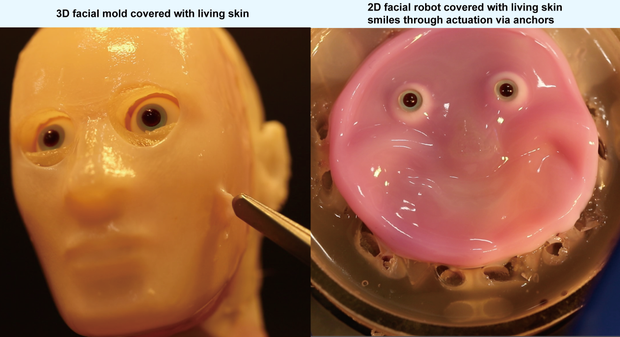CBS News
This pink blob with beady eyes is a humanoid robot with “living skin”

A pink blob with beady eyes is gaining widespread attention online – because this newly-developed robot has what researchers call “living skin.”
Professor Shoji Takeuchi of the University of Tokyo developed the alien-like machine using engineered skin attached to a humanoid robot.
Takeuchi previously created walking mini robots using 3D-printed lab-grown meat, engineered skin and biological muscle tissue. He decided to continue to develop the skin feature, which was grown in the Biohybrid Systems Laboratory at the university.
©2024 Takeuchi et al.
“During previous research on a finger-shaped robot covered in engineered skin tissue we grew in our lab, I felt the need for better adhesion between the robotic features and the subcutaneous structure of the skin,” Takeuchi said in a news release. “By mimicking human skin-ligament structures and by using specially made V-shaped perforations in solid materials, we found a way to bind skin to complex structures.”
He said the natural flexibility of the skin and its strong adhesion to the robot make it so that the skin can move without peeling or tearing. The researchers used collagen for adhesion and plasma treatment to move the collage into the perforations of the robots’ mechanics. With this method, the skin can be added to any surface.
But, he said, this method is much harder than people might think because bacteria can enter the skin and the tissue can die.
Unlike chemical-based materials used to make skin, the living skin can self-heal, which Takeuchi said was a big deal.
©2024 Takeuchi et al.
The pink blob was just the 2D model of the living skin robot. The researchers also made a 3D model with a more human-like head shape. Takeuchi said the next challenge is making the skin thicker and adding features like wrinkles to make it more human-like.
“We believe that creating a thicker and more realistic skin can be achieved by incorporating sweat glands, sebaceous glands, pores, blood vessels, fat and nerves,” he said in the news release. “Of course, movement is also a crucial factor, not just the material, so another important challenge is creating humanlike expressions by integrating sophisticated actuators, or muscles, inside the robot.”
“Creating robots that can heal themselves, sense their environment more accurately and perform tasks with humanlike dexterity is incredibly motivating,” he said.
So, what might these human-like living skin robots be used for? Takeuchi says these robots can be used in medical research like drug development and can also be used in skin aging, cosmetics research and plastic surgeon training.
CBS News
Biden’s immigration spouse program struck down

Watch CBS News
Be the first to know
Get browser notifications for breaking news, live events, and exclusive reporting.
CBS News
Massive fires in both U.S coasts force evacuations, destroy homes

Watch CBS News
Be the first to know
Get browser notifications for breaking news, live events, and exclusive reporting.
CBS News
Despite pressure on Sotomayor, Supreme Court unlikely to change before Trump takes office. Here’s why.

Washington — President-elect Donald Trump’s victory Tuesday has stirred up whispers about whether Justice Sonia Sotomayor should step down from the Supreme Court to allow President Biden to nominate a successor before Republicans take control of Washington.
But any changes in the composition of the nation’s highest court are unlikely in the coming months, even as lawmakers return for a lame-duck session to finish their business before Trump is sworn in for a second term and the GOP assumes the Senate majority.
Sotomayor hasn’t responded publicly to the chatter about a retirement, and she did not return a request for comment about her future. She remains an active questioner during oral arguments and has become known for biting dissents in hotly contested cases.
At 70, she is not the oldest member of the Supreme Court — Justice Clarence Thomas is 76 and Justice Samuel Alito is 74 — and she is newly into her tenure as the senior-most member of its liberal wing, a position she assumed following the retirement of Justice Stephen Breyer in 2022.
Sotomayor, the first Hispanic justice, is also a decade younger than Justice Ruth Bader Ginsburg was when she faced pressure to step down from the Supreme Court in 2013 and 2014.
Ginsburg, who was treated for early-stage colon cancer in 1999 and pancreatic cancer in 2009, rejected any suggestion that she retire to allow then-President Barack Obama to name a successor while Democrats had control of the Senate. She remained on the Supreme Court until her death in September 2020, after which Trump, nearing the end of his first term, selected Justice Amy Coney Barrett to fill her seat. Barrett’s confirmation by the GOP-led Senate widened the Supreme Court’s conservative majority to 6-3.
With a second term for Trump on the horizon, and Democrats losing control of the Senate come January, when Republicans will hold at least 52 seats, progressives are fearful of a repeat of what happened with Ginsburg’s seat.
“We have no idea how long it will be until somebody who shares Justice Sotomayor’s jurisprudence, her values will be in a position to be nominated again,” Molly Coleman, executive director of the People’s Parity Project, a progressive judicial group, told CBS News. “Of course we all want to hope for the best, but unfortunately we’ve been left in a position where that’s all we can do.”
The circumstances of more than a decade ago are different from today, making it far from a sure thing that even if Sotomayor were to retire, the Senate would confirm her replacement before the GOP takes over. For one, Democrats currently have a narrow 51-49 majority, which includes the four independent senators who vote with the party.
One of those senators, Joe Manchin of West Virginia, told Politico in March that he would not support nominees who do not have GOP support.
“Just one Republican. That’s all I’m asking for. Give me something bipartisan. This is my own little filibuster. If they can’t get one Republican, I vote for none. I’ve told [Democrats] that. I said, ‘I’m sick and tired of it, I can’t take it anymore,'” Manchin, who is retiring from the Senate, said.
He later appeared to slightly reverse course, voting in September to advance the nomination of a candidate for a federal appeals court. A spokesperson for the senator told Axios at the time that Manchin learned opposition to the nominee was based on how the White House handled the process, not qualifications.
Erwin Chemerinsky, the dean of the University of California Berkeley Law School, said there is not enough time for a successor to be nominated and confirmed by the Senate by early January. Incoming House and Senate members will be sworn in on Jan. 3, and the results of the election will be reaffirmed by Congress on Jan. 6.
“Joe Manchin made clear he would not vote for any nominee without Republican support and no Republican would vote for a Biden nominee to replace Sotomayor. Sotomayor retiring now would likely just give Trump a vacancy to fill. It is totally different from whether Ginsburg should have retired in summer 2014 before the election,” he told CBS News in an email.
Chemerinsky wrote in September 2014 that Ginsburg should have retired that summer and warned her decision not to “could end up hurting her legal legacy.” Democrats had control of the Senate at that time, but lost it following the November 2014 midterm elections.
Even some progressive groups that called for open discussions about Sotomayor’s future on the court months ago are recognizing that the window has closed.
“The reality is it’s too late. It’s too late for Democrats to be having this conversation. It’s too late to be launching a pressure campaign. The ship has sailed,” Coleman, of the People’s Parity Project said.
She said discussions should have happened earlier this year and warned the consequences of waiting may be “catastrophic.”
Instead, liberal judicial advocacy groups are turning their focus to the confirming Mr. Biden’s remaining nominees to the federal district and appeals courts. There are currently 47 open seats on the federal bench, and 17 nominees are awaiting Senate action. There will be another 20 vacancies in the coming weeks, and 11 nominees are pending for those seats.
“Hand wringing about the unknown doesn’t help anyone right now,” said Maggie Jo Buchanan, managing director of the judicial group Demand Justice. “Right now, we are firmly focused on the fact that there are still 30 pending Biden nominees before the Senate that deserve, and need, confirmation. The Senate should be focused on working late, working weekends to get these talented individuals on the bench.”
Trump saw immense success with judicial confirmations during his first term, appointing 234 jurists to the Supreme Court, federal courts of appeals, district courts and U.S. Court of International Trade. But Mr. Biden is closing in on that number, with 213 appointments so far.










